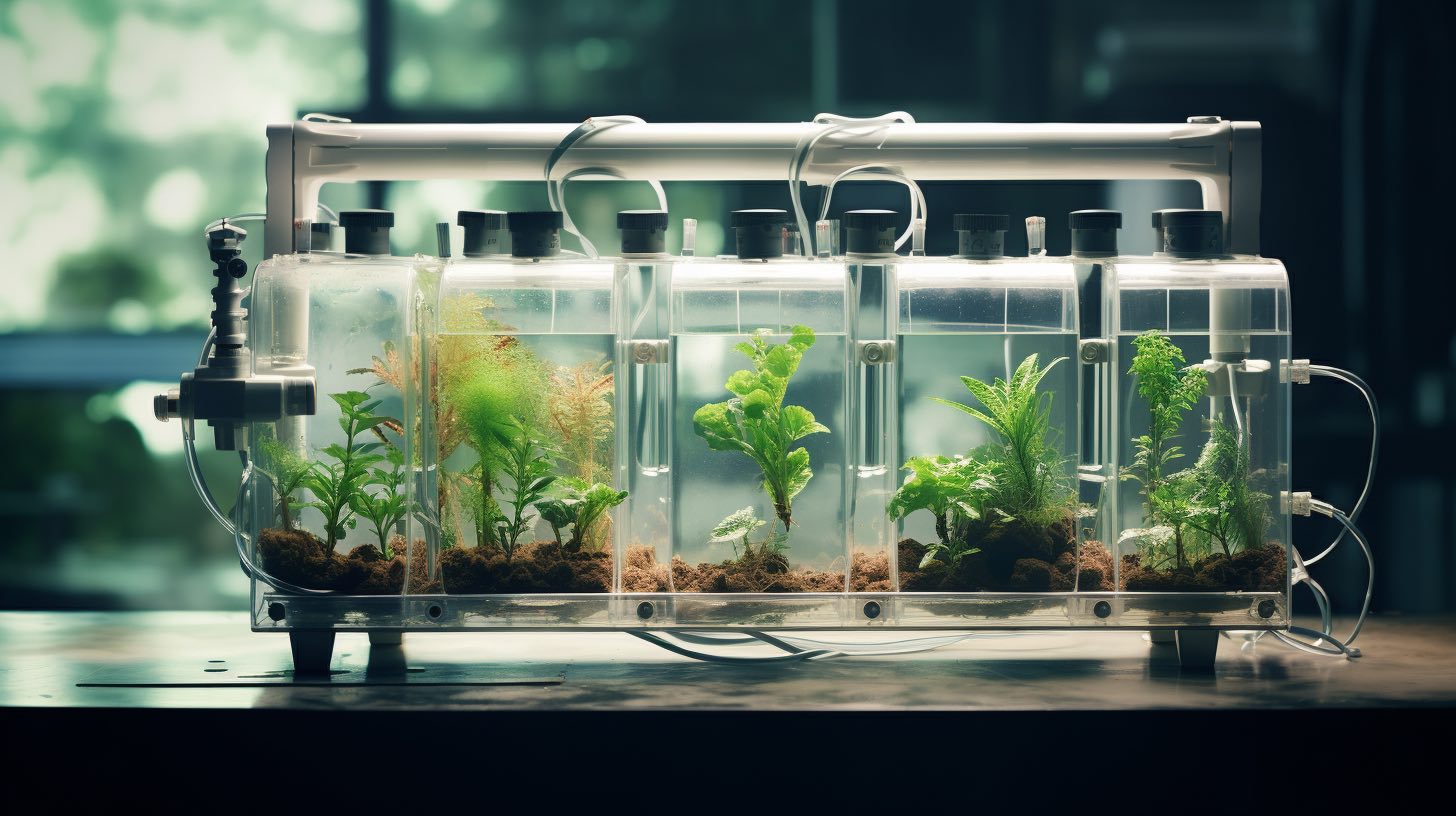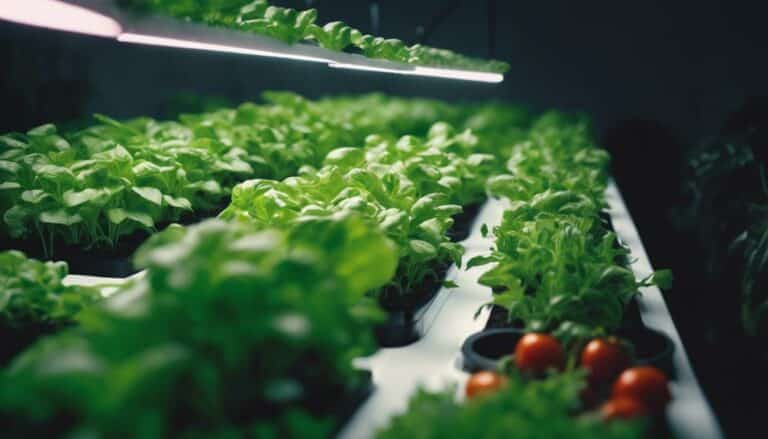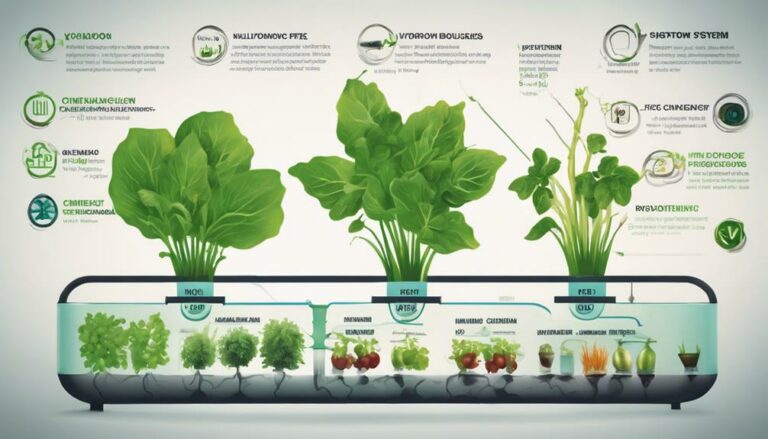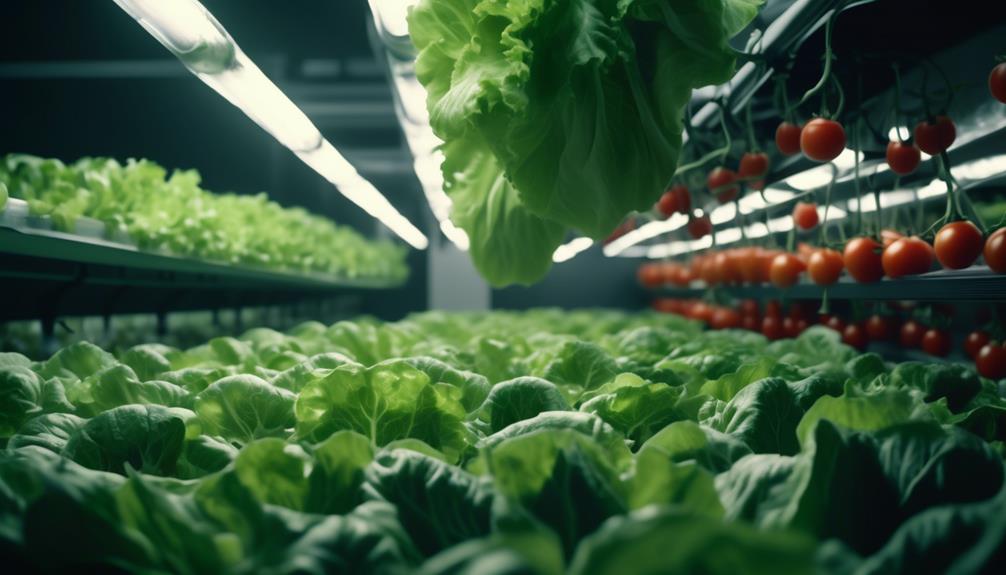Welcome to our comprehensive guide on Kratky hydroponics. This step-by-step article aims to provide you with the knowledge, details, and informative insights to successfully implement this innovative method of growing plants.
Table of Contents
From understanding the basics of Kratky hydroponics to selecting the right plants, gathering materials, and maintaining the nutrient solution, we will cover everything you need to know.
With our guidance, you will soon be able to enjoy a bountiful harvest of your own Kratky hydroponic produce.
Key Takeaways
- Kratky hydroponics is a passive hydroponic system with simplicity, low cost, and water efficiency.
- Plants with low nutrient demand and tolerance to stagnant water conditions are suitable for Kratky hydroponics.
- Nutrient solution formulation, regular testing, and observation are important to prevent nutrient deficiencies in Kratky hydroponics.
- Proper container selection, material gathering, and maintenance techniques are crucial for successful Kratky hydroponics.
Understanding Kratky Hydroponics
Kratky hydroponics is a passive hydroponic system that allows plants to grow without the need for electricity or water pumps. This innovative technique was developed by Dr. Bernard A. Kratky at the University of Hawaii.
One of the main benefits of Kratky hydroponics is its simplicity and low cost. It requires minimal equipment and can be easily set up by beginners. Another advantage is its water efficiency, as the system only uses the necessary amount of water for the plants to grow.
However, there are also drawbacks to consider. Since there is no active circulation of nutrients, the plants may not receive an optimal supply, which can affect their growth and yield. Additionally, the lack of aeration can lead to root rot or other oxygen-related issues.
Despite these drawbacks, Kratky hydroponics is an excellent option for small-scale gardening or for growing plants with low nutrient demands.
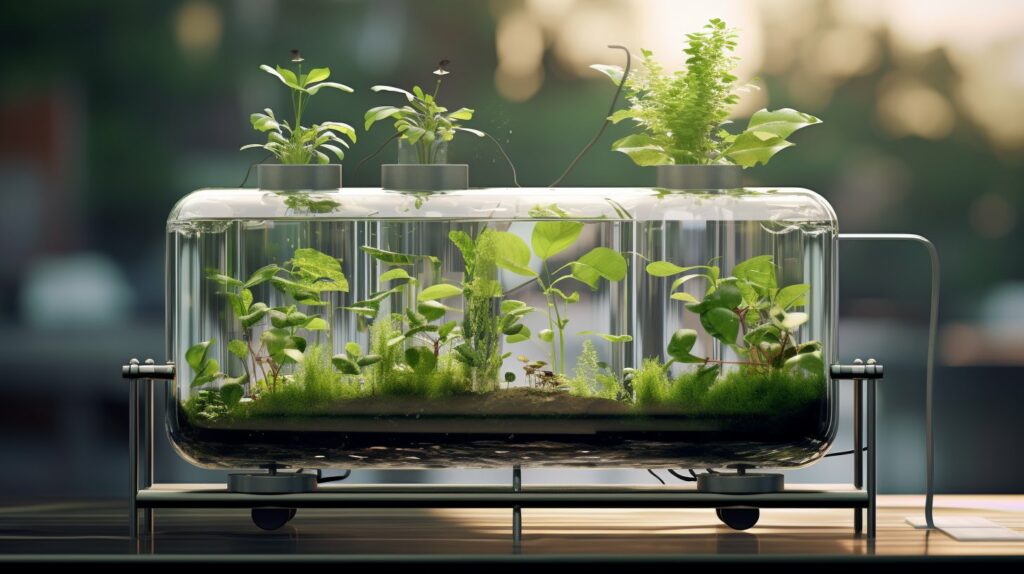
Selecting the Right Plants for Kratky Hydroponics
When it comes to selecting the right plants for Kratky hydroponics, it is important to consider the specific requirements of each plant. Some plants are better suited for this growing method than others, as they can thrive with minimal water and nutrient availability.
It is crucial to choose plants that have a low nutrient demand and can tolerate stagnant water conditions, as these are the key characteristics of the Kratky system.
Best Kratky Plant Options
Some of the best plant options for the Kratky hydroponics system include lettuce, herbs, and leafy greens.
The Kratky method is a popular alternative hydroponic system that requires no electricity or water circulation. It is a passive system that uses a static nutrient solution, allowing plants to absorb water and nutrients as needed.
Lettuce varieties such as romaine, butterhead, and leaf lettuce are ideal for the Kratky system due to their shallow root systems and relatively fast growth rates.
Herbs like basil, cilantro, and parsley also thrive in this system, providing fresh flavors for culinary use.
Leafy greens, such as spinach and Swiss chard, are also suitable choices, as they grow well in nutrient-rich environments and can be harvested multiple times.
When selecting plants for the Kratky system, it is important to consider their growth habits, nutrient requirements, and compatibility with the static nutrient solution.
Nutrient Requirements for Plants
Plants grown using the Kratky method require specific nutrient requirements to ensure optimal growth and development. Nutrients are essential for plants to carry out their metabolic processes, and deficiencies can lead to stunted growth, poor yields, and even plant death.
To prevent nutrient deficiencies, it is crucial to provide plants with a well-balanced nutrient solution. The nutrient solution formulation for Kratky hydroponics typically consists of macronutrients such as nitrogen (N), phosphorus (P), and potassium (K), as well as micronutrients like iron (Fe), calcium (Ca), and magnesium (Mg).
It is important to monitor the nutrient levels throughout the growing cycle and adjust the solution as needed. Regular testing and observation can help identify any deficiencies and allow for prompt corrective action.
Gathering the Necessary Materials
To successfully implement the kratky hydroponics method, it is essential to gather all the necessary materials prior to starting the process.
The first step is to set up the hydroponic system. This involves selecting a suitable container for your plants. It is important to choose a container that is large enough to accommodate the root system of your plants and has enough space for the water and nutrient solution. Additionally, the container should be made of a non-toxic material that is resistant to water damage. Common container options include plastic buckets, bins, or even PVC pipes.
Once you have chosen the container, you will also need to gather other materials such as an air stone, air pump, net pots, growing medium, and a pH testing kit. These materials are necessary for creating the optimal growing environment for your plants.
Preparing the Kratky Hydroponic Container
The first step in preparing the hydroponic container is to ensure it is clean and free from any debris or contaminants that could potentially harm the plants. This is crucial for maintaining a healthy and productive hydroponic system. Here are four important steps to follow for container preparation:
- Clean the container thoroughly: Wash the container with warm water and mild soap to remove any dirt or residue. Rinse it well to ensure no soap residue remains.
- Sanitize the container: Use a sanitizing solution, such as a mixture of bleach and water, to disinfect the container. This will help eliminate any potential pathogens or harmful bacteria that could harm the plants.
- Rinse the container: After sanitizing, thoroughly rinse the container with clean water to remove any traces of the sanitizing solution.
- Dry the container: Allow the container to air dry completely before using it for your hydroponic system. This will prevent any moisture or dampness that could promote the growth of mold or fungi.
Following these steps will ensure that your hydroponic container is clean, safe, and ready for use.
Additionally, proper container selection is also essential for a successful hydroponic setup. Consider factors such as size, material, and drainage capabilities when choosing a container for your plants.
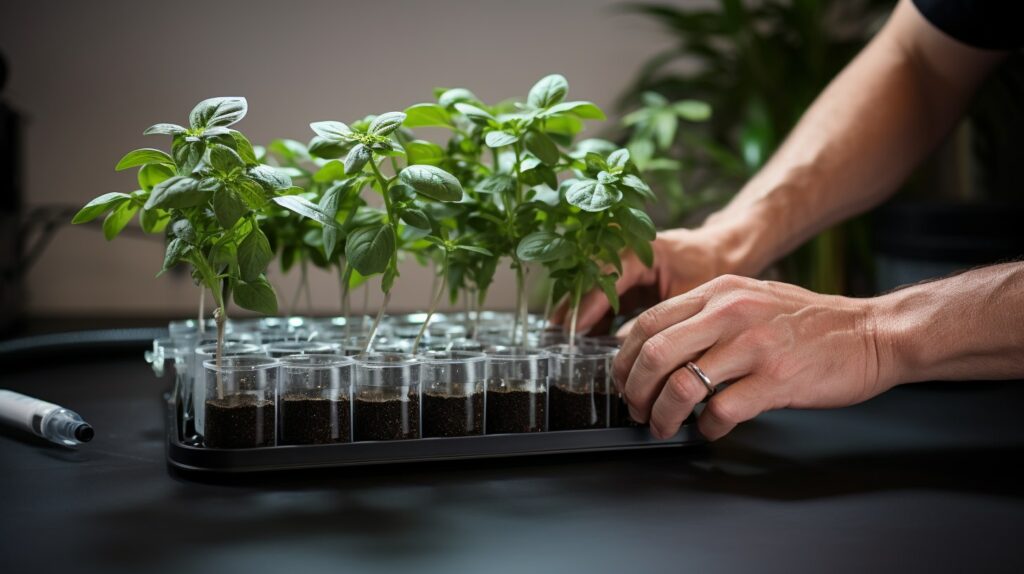
Mixing the Nutrient Solution
Properly mixing the nutrient solution is crucial for ensuring the plants receive the necessary nutrients for healthy growth and development. The nutrient solution provides essential elements such as nitrogen, phosphorus, and potassium, as well as micronutrients like iron, manganese, and zinc. Achieving the correct nutrient ratios is vital to prevent deficiencies or toxicities that can harm the plants. Here is a table summarizing the recommended nutrient ratios for different plant stages:
| Nutrient | Vegetative Stage | Flowering Stage | Fruit Ripening Stage |
|---|---|---|---|
| Nitrogen | 3:1:2 | 1:2:2 | 1:1:2 |
| Phosphorus | 1 | 2 | 2 |
| Potassium | 2 | 2 | 3 |
Troubleshooting tips for nutrient solution-related issues include checking the pH level (ideal range: 5.5-6.5), adjusting nutrient concentrations, and ensuring proper aeration and circulation within the system. Regular monitoring and adjustment of the nutrient solution will help maintain optimal plant health and maximize yields.
Planting and Transplanting in Kratky Hydroponics
Planting and transplanting in the Kratky hydroponic system requires careful consideration of the appropriate plant species and stage of growth to ensure successful establishment and development. Here are some key factors to consider when it comes to planting techniques and container size in Kratky hydroponics:
- Choose the right plant species: Certain plants are better suited for the Kratky system, such as leafy greens, herbs, and smaller fruiting plants. These plants have shallow root systems and thrive in stagnant nutrient solutions.
- Start with seedlings or young plants: Transplanting seedlings or young plants is recommended to ensure they adapt well to the hydroponic environment. This allows for easier nutrient uptake and minimizes transplant shock.
- Use appropriately sized containers: The container size should match the plant’s growth requirements. Smaller plants can be grown in individual containers, while larger plants may require larger containers or shared containers to accommodate their root systems.
- Maintain proper water level: In the Kratky system, the water level should be initially set at the bottom of the net pot and gradually decrease as the plants grow and consume the nutrient solution.
Monitoring and Adjusting the Water Level
Monitoring and adjusting the water level is a crucial aspect of maintaining a successful kratky hydroponics system. By regularly checking the water level, you can ensure that it remains at the optimal level for plant growth and nutrient uptake.
Adjustments may be necessary to prevent water fluctuations, which can lead to stress or nutrient deficiencies in plants.
Water Level Maintenance
Maintaining the appropriate water level is crucial for the success of a kratky hydroponics system. In order to ensure optimal plant growth and prevent any issues, it is important to pay attention to water evaporation and troubleshoot any water level problems that may arise.
Here are four key tips to help you maintain the water level in your kratky hydroponics system:
- Preventing water evaporation: Covering the reservoir with a lid or using a floating raft can help minimize water loss through evaporation.
- Regular monitoring: Check the water level daily to ensure it remains at the appropriate level. This will prevent the plants from becoming waterlogged or dehydrated.
- Adjusting water level: If the water level drops too low, add more water to maintain the proper depth. Conversely, if the water level is too high, remove some water to prevent root rot.
- Troubleshooting water level issues: If you notice consistent fluctuations in the water level, check for leaks in the system, adjust the water level indicator, or consider adding a water level sensor for more accurate monitoring.
Preventing Water Fluctuations
Water level stability is crucial in a hydroponic system to promote consistent plant hydration and prevent any fluctuations that may hinder growth. Maintaining a stable water level requires effective water level control and regular water quality testing.
Water level control involves monitoring the water level in the reservoir and adjusting it as needed to ensure it remains at the optimal level for plant growth. This can be achieved through the use of float valves or electronic sensors that automatically adjust the water level.
Additionally, regular water quality testing is essential to ensure that the water in the system is free from contaminants and has the necessary nutrients for plant growth. This can be done through pH and nutrient testing, as well as checking for any signs of algae or bacterial growth.
Maintaining the Nutrient Solution
To ensure optimal nutrient levels in the hydroponic system, regular testing and adjustment of the solution is essential. Nutrient solution troubleshooting can help identify any imbalances or deficiencies that may be hindering plant growth. Here are four important steps to maintaining the nutrient solution:
- Test the solution regularly: Use a nutrient testing kit to measure the levels of essential elements such as nitrogen, phosphorus, and potassium. This will help you determine if any adjustments are necessary.
- Adjust pH levels: pH plays a crucial role in nutrient availability. If the pH is too high or too low, it can affect the absorption of nutrients by the plants. Use pH adjusters to maintain a range of 5.5-6.5.
- Monitor and adjust nutrient concentrations: Over time, the nutrient solution may become depleted or imbalanced. Regularly monitor the levels of nutrients and adjust accordingly by adding concentrated nutrient solutions.
- Proper nutrient solution storage: Store your nutrient solutions in a cool and dark place to prevent degradation. Ensure that containers are tightly sealed to prevent contamination.
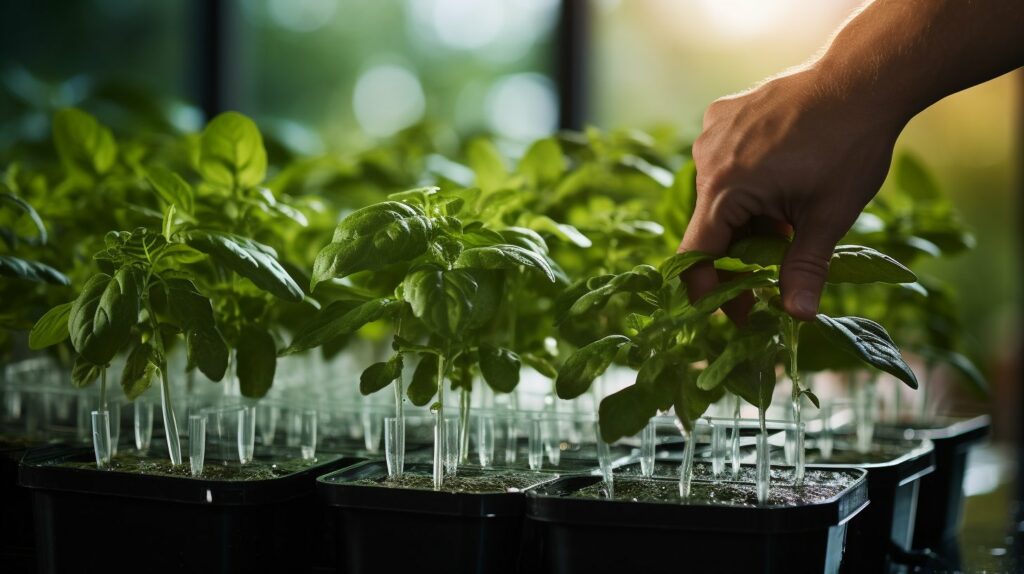
Preventing and Managing Pests in Kratky Hydroponics
Pest prevention and management are crucial aspects of maintaining a successful kratky hydroponics system. By implementing effective pest control strategies, you can protect your plants from damage and ensure their healthy growth. Organic pest control methods are preferable in kratky hydroponics to avoid introducing harmful chemicals into the nutrient solution.
To prevent and manage pests in kratky hydroponics, it is essential to regularly inspect your plants for any signs of infestation. Implementing physical barriers, such as fine mesh screens, can help prevent pests from entering your growing area. Additionally, introducing beneficial insects like ladybugs or lacewings can help control pest populations naturally.
Here is a table outlining common pests in kratky hydroponics and organic pest control methods to manage them effectively:
| Pest | Description | Organic Pest Control Methods |
|---|---|---|
| Aphids | Small, soft-bodied insects that suck sap from plants | Use insecticidal soap or neem oil. Introduce ladybugs or lacewings. |
| Whiteflies | Tiny, white insects that fly around plants and leave a white, powdery residue | Use yellow sticky traps. Apply insecticidal soap or neem oil. |
| Thrips | Slender, winged insects that feed on plant juices | Use yellow sticky traps. Apply insecticidal soap or neem oil. |
| Spider Mites | Small arachnids that feed on plant sap, causing yellowing and webbing | Apply horticultural oil or insecticidal soap. Increase humidity levels. |
Harvesting and Enjoying Your Kratky Hydroponic Produce
Harvesting the produce from your hydroponic system is the culmination of your hard work and dedication, allowing you to enjoy the fresh and nutritious fruits and vegetables you have grown. To make the most of your harvest, here are some techniques to consider:
- Timing: Harvest your plants when they are at their peak ripeness. This ensures maximum flavor and nutrition.
- Handling: Use clean, sharp tools to avoid damaging the plants. Cut the produce above the growth medium to prevent contamination.
- Washing: Rinse your harvested produce gently with water to remove any dirt or debris. This helps maintain their freshness and cleanliness.
- Storage: Store your harvested produce properly to prolong their shelf life. Some crops, like leafy greens, can be stored in airtight containers in the refrigerator, while others, like tomatoes, are best stored at room temperature.
Is Greencoast Hydroponics a Suitable Option for Beginners?
Is Greencoast Hydroponics a suitable option for beginners? With its wide range of greencoast hydroponics products, it offers a beginner-friendly approach to hydroponic gardening. From nutrient solutions to grow lights, their products ensure a smooth learning curve for novices in this field. With their comprehensive guides and support, Greencoast Hydroponics is an excellent choice for beginners venturing into hydroponics.
Frequently Asked Questions
Conclusion
In conclusion, Kratky hydroponics offers a simple and low-maintenance method for growing plants without the need for electricity or complicated systems.
By selecting the right plants, gathering the necessary materials, and properly preparing the hydroponic container, anyone can enjoy the benefits of this innovative gardening technique.
With careful monitoring and maintenance of the nutrient solution, as well as effective pest management, growers can harvest and enjoy their own fresh produce using the Kratky hydroponics method.

